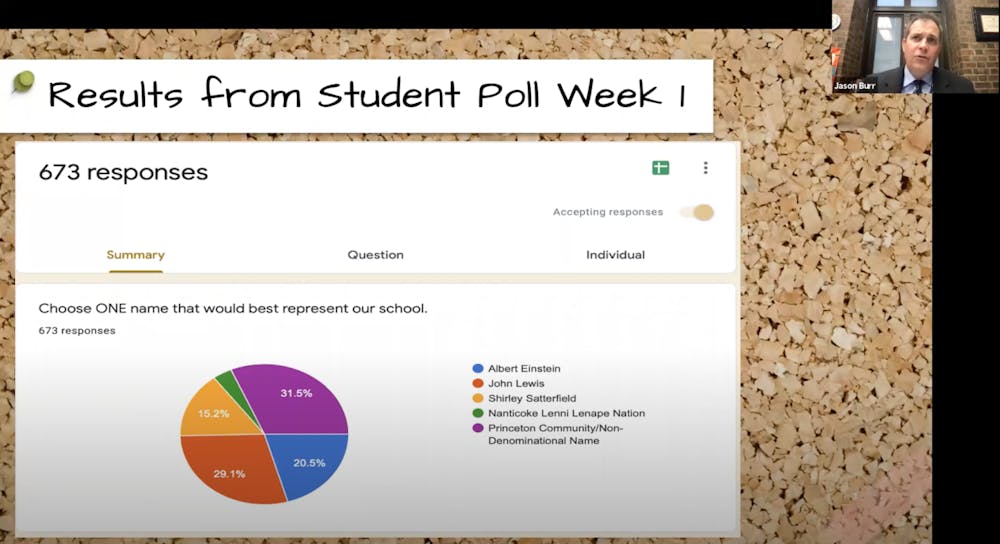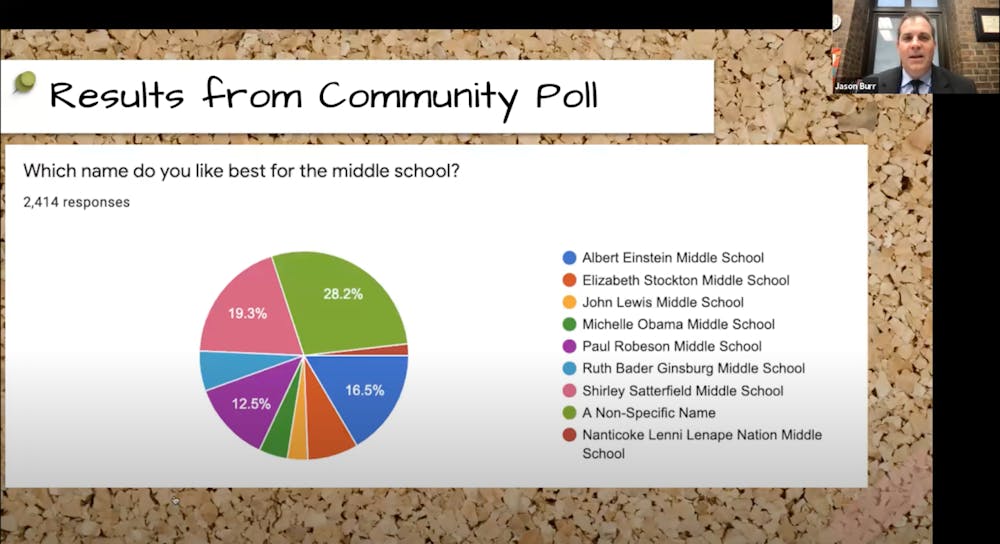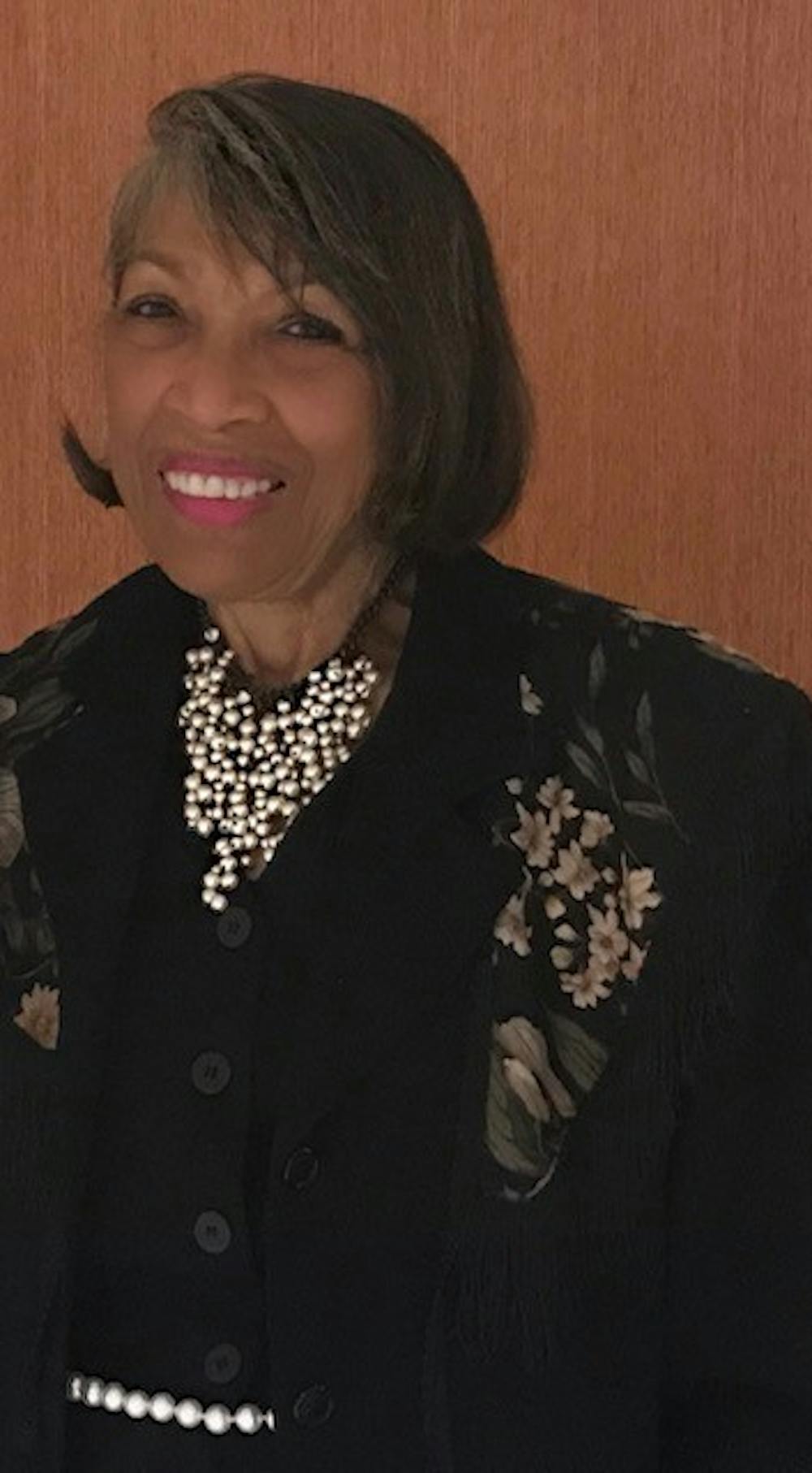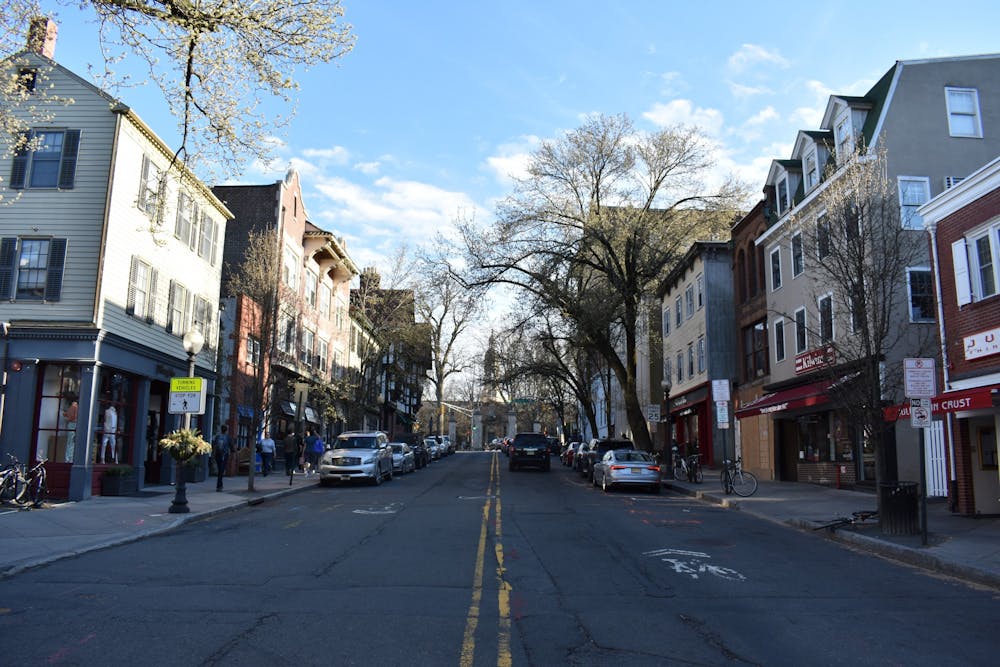After a year of deliberation, research, and advocacy for possible namesake candidates, the school that once bore John Witherspoon’s name has been renamed “Princeton Middle School” following an 8–1 vote on June 15 by the Princeton Board of Education.
The choice to go with a non-specific name has resulted in community outrage and concerns about an anti-democratic process — especially within the widespread movement calling for the school to be named after Shirley Satterfield, a renowned local historian and educator of Princeton’s African American community.
“It’s a tragedy that the members of the Board of Education have decided not to listen to the voice of the people,” said Rev. Lukata Mjumbe, Pastor at Witherspoon Street Presbyterian Church.
The renaming comes after the Board’s unanimous vote to remove John Witherspoon’s name from the school on Aug. 11, 2020, a decision brought on by Princeton High School alumnus Geoffrey Allen’s petition urging the town to “rid itself of its slave-owning and anti-abolitionist namesake” in solidarity with the Black Lives Matter movement. The petition gained 1,549 signatures in the span of two months following the University’s June 2020 removal of Woodrow Wilson’s name from its public policy school and residential college.
Over the past year, Princeton residents and students have deliberated over possible names for the middle school. Princeton High School U.S. history students first selected and researched namesake contenders. Then eighth grade civics students created video biographies and descriptions of the 10 finalists. The final contenders featured eight individuals — including Satterfield, Elizabeth Stockton, and Michelle Obama — and two non-specific place-based options, Princeton Community Middle School (PCMS) and Walnut Lane Middle School (WLMS).
The middle school conducted two student polls on Jan. 29 and Feb. 5, each following school-wide viewings of the candidates’ student-made video descriptions. In the first, 31.5 percent of 673 votes were cast for PCMS/Non-Denominational Name, and in the second 36.4 percent of 646 were for WLMS/Non-Denominational Name.

Among the town’s middle school students, Shirley Satterfield earned 15.2 percent of votes in the first week of polling — a statistic displayed during a Zoom meeting of the Princeton Board of Education.
Ellen Li / The Daily Princetonian


In a second student poll, four additional names were presented alongside the “Non-Specific Name” option, including Elizabeth “Betsey” Stockton and Paul Robeson.
Ellen Li / The Daily Princetonian
In the following community poll, which was live from March through April 10, Shirley Satterfield Middle School received 19.3 percent of 2,414 votes — a plurality among the 10 finalists. The Daily Princetonian obtained documents showing the raw poll results, allowing for verification of these numbers.

“Shirley Satterfield Middle School” earned the highest individual vote share among community members, but the presented results combined many names into a single segment titled “A Non-Specific Name” — including joke responses.
Ellen Li / The Daily Princetonian
However, the poll was structured so that votes for PCMS, WLMS, and write-ins were grouped under a single category. At the May 25 Board meeting, Principal Jason Burr presented a pie chart showing a 28.5 percent community preference for “A Non-Specific Name” — a percentage comprised of the 14.5 percent who voted for PCMS, 8.8 percent for WLMS, and 119 write-ins (4.9 percent), which ranged from calls to preserve John Witherspoon’s name to “Melania Trump Middle School” to an entry which read, “Yooooooooooooooooooooooo!!!!!!!!!!!!”

As the Board settled on the name “Princeton Middle School,” the winner of a student and staff ranked-choice vote between five non-person names, community members noted that the name hadn’t appeared in any of the polls conducted prior — and that many people, including Burr, had been concerned about its unfortunate acronym, “PMS.”
“Community-based place names (non-person names) were the most popular in both the student vote and the community poll,” a Board spokesperson wrote in an email to the ‘Prince.’ “After considering the options, the Board selected the name Princeton Middle School. PPS [Princeton Public Schools] is proud to be among the first institutions in town to remove the name of a slaveholder from its named facilities.”
Many respondents did prefer a non-specific name, including one community member who thought that “adding the name of a person that has any relation to politics may cause some issues.” Still, several residents were outraged that the Board chose not to acknowledge Satterfield’s plurality.
Mjumbe described the Board’s actions as “insulting, illogical, and in many ways, reminiscent of the legacy of voting fraud that we have found in the African American community.”
“If you want to use the voter fraud logic of collapsing categories, then how about you collapse all of the voters that voted for Black women?” he added.
Satterfield’s daughter, Dawn Collins, also expressed her disappointment in the renaming process at the June 15 board meeting where the Board’s vote took place.
“You should understand how that feels to the Black citizens of Princeton,” she said, “whose input, whose civic engagement, and whose will seems to be so easily dismissed aside by a board that seems to lack diversity, and inflicts the same exact harm and trauma that the renaming sought to cure.”
Satterfield herself was unsurprised by the Board’s decision, saying, “I know Princeton, and there’s still a sense of inequality in this town.”
In correspondence with community members and the ‘Prince,’ Board officials have cited the district’s Policy 7550, enacted in 2005, to justify the adoption of a non-specific name. The policy reads, “school buildings, subsequent to the date of this policy, shall not be named after individual persons.”
Satterfield expressed concern that a bylaw preventing the renaming of the building for a specific individual was only cited so late in the process, especially after a months of encouraging student research into namesake candidates like herself.
Ali Wilson, one of Satterfield’s former students, concurred.
“The rules changed,” he said. “How could you not make sure from the beginning that she couldn’t be a candidate, that the school couldn’t be named for someone?”
“Given the history of Princeton, whether it was intended or not, for some it will look like it was racial,” Wilson continued. “Because you didn’t want the school to be named for a Black person.”
The ‘Prince’ asked the Board for comment on why the policy was not initially brought to the public’s attention and was told that the Board was “prepared to revisit the existing naming policy” from the beginning of the name search “depending on student and community input.”
“However,” Board president Beth Behrend wrote in an email to the ‘Prince,’ “based on the data gathered (including multiple polls) during the ten-month renaming process, the administration recommended a non-person-specific name, which the board then approved.”
The Board’s actions were exceptionally disappointing to community members who had put months of energy into engagement with the renaming process.
In March, Mjumbe spearheaded a canvassing campaign to spread awareness about the poll, urging neighbors to vote for Shirley Satterfield. Community members knocked on doors throughout Princeton, sharing Satterfield’s history as an educator in the PPS district and as the leading local historian of Princeton’s African American community and founder of the Witherspoon-Jackson Historical and Cultural Society.
“She is a living legend,” Mjumbe said. “She has represented a commitment to unify different people within the Princeton community, where in so many ways, John Witherspoon and his identity as a slave owner, represented the opposite.”
Shirley Satterfield in the PPS district
Satterfield, whose family has lived in Princeton since the 1870s, grew up on Old Clay Street — a street where many African American Princetonians lived before 1952, but has since been replaced by the Hageman Homes apartment complex.
Satterfield told the ‘Prince’ that she began her education at the Witherspoon School for Colored Children on Quarry Street, where her teachers taught her to be proud and to understand “the history of our people.”
“But all of that was lost when they integrated the schools,” she said.
In 1948, the Princeton Plan integrated the town’s Black students with the white students who attended Nassau Street Elementary School, where Shirley completed her elementary education. She then returned to the Witherspoon School, which now served all middle-school students in Princeton, and later attended Princeton High School.
For Satterfield, the Princeton Plan meant losing her caring Black teachers. The teachers she had after 1948 didn’t expect Black students to do as well as white students — even though test scores went up as a result of the quality education Black students had received prior. “While there was integration on the outside,” she said, “there was segregation on the inside.”
Satterfield further recalled that she and her African American peers were not encouraged to attend college.
Nevertheless, Satterfield attended Rider College (now Rider University) and transferred to Bennett College for Women in Greensboro, N.C. for a degree in elementary education. She went on to teach in several different middle and elementary schools for decades, working as a guidance and college counselor at Hightstown High School for 14 years and then at Princeton High School, where she served from 1993 to 2006.

A photo of Satterfield, longtime historian and educator in Princeton, NJ.
Shirley Satterfield for The Daily Princetonian
Jason Carter, current teacher and parent in the PPS district, recalled that his freshman year at PHS was also Satterfield’s first year as a counselor. “No one knew who she was,” Carter said, but they had a surprising connection.
“She was best friends with my late aunt,” he remembered. “When I came to high school, she said, ‘You’re a Carter?’ and I said yes... Ever since that moment, she treated me like I was her younger brother or son.”
When Satterfield arrived at PHS, there were no enrichment programs for African American students. As Carter remembered, “being Black in Princeton High School at that time, there were clearly teachers that were biased against you, and Shirley knew it.”
“I can’t be a savior to students,” Satterfield remembered saying to herself. “But I want to see that every student gets a fair chance to get the education that he or she deserves.”
At PHS, she started several projects for the advancement of African American youth and other students from underserved communities, including PULSE (Pride, Unity, Leadership, Sisterhood, Esteem), which encouraged young women to give back to their communities. Satterfield also involved PPS in existing nationwide enrichment programs, including INROADS and LEAD.
Dedicated to her work as an educator and counselor — work that came “all from [her] heart” — Satterfield spent her summers visiting every college in the New England area and taking her students to visit many of them, as well as many historically Black colleges and universities in the South.
“It really opened my eyes to the possibility,” Carter said, remembering the series of college tours Satterfield organized for African American students in Mercer county. “She used to tell me all the time: you do not want to be a statistic, Jason, you have the skills, you have the talent. You can do something great.”
Wilson, who had Satterfield as a counselor at Hightstown High School, remembers her as a loving role model, “almost like a parent,” who helped him start a Black history club.
“A Christ-like type of love flows from her. We need more people like her that young people gravitate to,” Wilson said. “The school being named for a person that had that to her core is essential to our future.”
#SurelyShirley: The movement for Satterfield and its aftermath
When Satterfield attended the first committee for the renaming of John Witherspoon Middle School in the fall of 2020, she gave a brief history of education in Princeton and suggested that the middle school be renamed for Elizabeth “Betsey” Stockton.
Stockton, born ca. 1798, was a former slave to Princeton University president Ashbel Green. Once freed, she worked as a missionary and educator in present-day Hawaii and Philadelphia, then returned to Princeton as a teacher in the African American community.
But as Carter, who was also in attendance, listened to Stockton’s story, it reminded him of Satterfield herself — “the new age Betsey Stockton,” he called her, a woman who connected Princeton’s African American community with the school district, raising Carter and his friends like a second mother.
“I’m not one to want glory. All I want to do is what comes from my heart,” Satterfield said. “When I found my name in the newspaper, I remember my minister saying, ‘Why didn’t you tell anyone?’”
That minister was Mjumbe — who, along with members of Princeton Mutual Aid (PMA), soon mobilized the community in a social media and canvassing campaign under the hashtag #SurelyShirley to raise awareness about Satterfield’s candidacy.
Despite these efforts and Sattefrield’s plurality in the community poll, the Board settled on the name “Princeton Middle School” in June.
Some saw this as a defeat, but efforts at advocacy have not stopped. In response to the renaming decision, residents presented two petitions to the Board at its July 28 meeting.
The first, presented by Hrishi Somayaji GS on behalf of Princeton Mutual Aid, expressed disappointment in “the Board’s refusal to acknowledge the community’s vote for Shirley Satterfield.”
“Amid the forces of privatization that continue to displace African-American families from our town,” the letter read, “‘Shirley Satterfield Middle School’ would have celebrated the struggle, fortitude, and community of generations of PPS students who hail from the Witherspoon Jackson neighborhood.”
“Instead,” the petition continued, “‘Princeton Middle School’ loudly proclaims the complicity of Princeton Public Schools in perpetuating generations of shameful racial injustice and erasure.”
The second letter, presented by Mjumbe and published in Planet Princeton, was signed by 26 ministers and faith leaders from the greater Princeton and Trenton area, as well as Professor of African American Studies Ruha Benjamin.
“Democratic decision-making is a hallmark of so many of our healthiest communities and best practices,” they wrote. “However, we were deeply discouraged when we learned of the decision to discount the indisputable choice made by the people of Princeton.”
“There is an extremely diverse and broad cross section of faith leaders that consider this [decision] to be morally offensive,” Mjumbe said. “The signers on the faith letter alone represent well over 10,000 people easily, in terms of all the congregations and organizations. What more do you need to say, ‘the people have spoken’?”
Carter further added that he thought the Board should prioritize the community poll over the student vote, noting that young students may not feel the deep impact Satterfield’s name represents to the broader townspeople.
“If I asked my kid what do you want to name the school,” Carter said, referring to his middle-school aged son, “he’d be like, ‘Will Smith.’”
In response to the publication of the faith leaders’ letter, the Board wrote that it was considering naming “hallways and other public spaces” for leading candidates like Satterfield and Stockton – but Satterfield told the ‘Prince’ that she found the suggestion upsetting.
“That’s what happens: we get to the top in Princeton and find that we are placed second best,” she said. “If you’re not going to name the school after me, do not put anything else in that building after my name.”
A spokesperson for the Board further directed the ‘Prince’ to an Aug. 13 article in TAPinto Princeton, which detailed architect Bob Hillier’s intention to rename the apartment complex at 184 Witherspoon Street, formerly the original Witherspoon School for Colored Children, after Satterfield, which he announced at an Aug. 2 reception.
However, Satterfield said that this dedication was planned three years ago.
“It has nothing to do with the renaming of the John Witherspoon Middle School,” she said.
Mjumbe found the move irrelevant as well as ironic in light of the local African American community’s struggles with gentrification.
“We cannot be confused,” he said. “This always has been and remains a movement to remove the name of a slave owner from a public institution and to create the opportunity to teach our children about the greater diverse legacy of our community through the renaming of a school supported by our tax dollars.”
“As we acknowledge the life and legacy of our beloved Shirley Satterfield in the naming of the building of a former segregated school for ‘colored children’ that is being expanded into upscale rental property by a private developer,” he added, “it is difficult to dismiss the disturbing irony.”
In the end, Satterfield said she’s not angry that the school wasn’t renamed for her, but she remains concerned about what she views as flaws in the democratic process. Her final concern was for her family.
“Six of my relatives were teachers in this system,” Satterfield said. “If my name were on that building, it would not be for me. It would be for my ancestors, and all of our families who scrubbed floors, who worked at the university eating clubs, who did everything in this town.”
For her grandmother, who was a primary teacher at the Witherspoon School for Colored Children in 1902 and taught the celebrated musician and activist Paul Leroy Robeson. For her two uncles, who attended PHS when it was first built in 1923. For her mother, who worked at PHS as the school district receptionist. For her uncle, the first Black man on Princeton’s Board of Education.
And for her students.
“Her name would be up there for all of us,” Carter said. “Her name would be up there for me, too.”
Editor’s Note: This piece was updated on Aug. 21 to remove a statement from the Board spokesperson.








